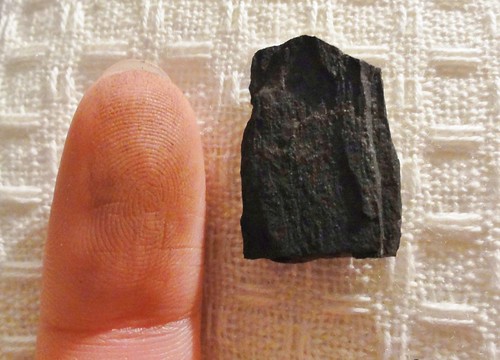This article was published in Scientific American’s former blog network and reflects the views of the author, not necessarily those of Scientific American
We all know charcoal, right? Most of us have taken bits of it from the ashes of wood fires and played with it. It's light, soft, and crumbly. It leaves a black sooty residue on everything it touches. It's marvelous stuff for drawing, even though it's prone to unintentional smudging. You can easily crush it to powder. Take a moment to imagine it. Score it with a fingernail. Remember how soft and delicate it is.
Now imagine taking a chunk of it from the ground, and seeing it blacken your fingers, but it's heavy.

It's rock! But it's charcoal! But it's rock! Credit: Dana Hunter
On supporting science journalism
If you're enjoying this article, consider supporting our award-winning journalism by subscribing. By purchasing a subscription you are helping to ensure the future of impactful stories about the discoveries and ideas shaping our world today.
You dig your fingernail into it, but instead of making an impression, your nail bends and leaves no mark. You gouge the head of your rock hammer with an edge of it, and instead of a black smear of particles, you're left with a shiny silver scratch in the metal.

Hard enough to scratch even a rock hammer. This is definitely not a soft metal: that's a very hard piece of charcoal! Credit: Dana Hunter
This amazing substance, neither plant nor rock, is called permineralized charcoal.
What a mouthful, right? But it's related to a familiar process: petrification. We know that when things petrify, minerals replace all of the existing material. When something like wood or charcoal is permineralized, the existing material isn't completely replaced; minerals like silica fill in cells, but leave the cell walls intact. If you look at thin sections of permineralized charcoal, the cellular detail can be extraordinary.
All you need to get permineralized charcoal is some burnt wood; groundwater saturated with iron, silica, calcite, or other such minerals; and a good stretch of undisturbed time. If that water and wood are in the ground, the humic acids that decaying organic matter produces helps the process along. As the minerals precipitate out from solution, they begin forming crystals in pores in the cell walls. From the walls, the minerals begin filling the interior cavity of each cell. When it's done, the cell walls remain intact around the new mineral-filled center of the cell.
If the water or mineral supply dwindles at this point, you're left with permineralized wood or charcoal. If the supply hadn't vanished, the process would have continued until every bit of organic matter was replaced by inorganic minerals, resulting in petrified wood.
Of course, dense minerals replacing the fluids within the cells means the formerly light bit of wood or charcoal is now quite heavy. And if the mineral is harder than steel, like silica, you get a piece of charcoal that has enough carbon left to soot up your fingers, but also scratch your specially-tempered rock hammer.
My friend Lockwood, who studied this stuff in depth and wrote up a paper on it for Oregon State University, sent me the following in an email, explaining how this works:
The key here is the term “permineralization,” and more specifically, “silicification.” I think those wikilinks will be clear, but the idea is that all the void spaces, including pores between the cell walls have been completely filled with silica, probably quartz. The reason that the pores are important is that it’s those interconnections that give the rock its overall coherence, toughness, and strength. Otherwise, each individual cell would easily break off from its neighbors. As you’ve seen, they don’t. As a proportion of mass and volume, the carbon is probably only a few percent of the total. So there’s enough exposed on fresh surfaces to smudge your fingers, but the bulk of the rock is crystalline quartz, and is very hard and tough. Incidentally, the carbon will eventually get rubbed off, and won’t smudge anymore, until you open up a new fresh surface.
The detail preserved is visible to the naked eye in many cases: in my samples from near Sweet Home, OR, you can clearly see growth rings. On a microscopic level, details of the cellular structure are easy to see. But the process obscures some of the details necessary to identify the species of wood: it takes some painstaking work with acid etching and scanning electron microscopes to determine what sort of tree contributed the necessary wood.

Growth rings in permineralized charcoal. Credit: Dana Hunter
Permineralization makes delicate charcoal some seriously tough stuff: my samples are comparatively young, but they're still millions, perhaps tens of millions, of years old. But samples as old as the Carboniferous are abundant. These ancient charcoals preserve evidence of fires that burned the earliest forests, and tell us a lot about what the earth was like long before mankind evolved.
You'd never expect something as delicate and ordinary as charcoal to survive for eons, but nature is wonderfully weird, and geologic processes can do some pretty extraordinary things.
References:
De Lafontaine, G. et al (2011): "Permineralization process promotes preservation of Holocene macrofossil charcoal in soils." J. Quaternary Sci., 26: 571-575
Enochs, Larry G., et al. (2002): "Unraveling the mystery of the Oligocene flora at Sweet Home, Oregon; a field study for K-12 teachers." In Field Guide to Geologic Processes in Cascadia
Gregory, Irene (1968): "The Fossil Woods near Holley in the Sweet Home Petrified Forest, Linn County, Oregon." The Ore Bin Vol. 30, No. 4